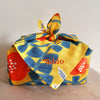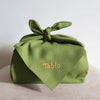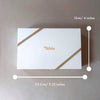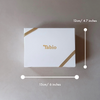Tabio have curated unique pieces that represent all elements of Japanese Art.
Ukiyo-e (浮世絵) is a genre of Japanese art which flourished from the 17th through 19th centuries. Its artists produced woodblock prints and paintings inspired by the beautiful colours and blends from Japanese nature, arts and culture.

SuSHI
Sushi, a globally renowned culinary delight, is a dish crafted from a combination of raw fish and other delectable ingredients skillfully paired with rice.
The history of sushi is intricately interwoven with Japanese art, reflecting a cultural fusion that spans centuries. In traditional Japanese art, depictions of sushi can be traced back to ukiyo-e woodblock prints from the Edo period (17th to 19th century).
The prints showcases the most popular types of sushi that can be found in restuirants across Japan and worldwide.
Daruma
Daruma, also known as Dharma dolls, holds a significant place in Japanese art and culture.
These dolls are based on Bodhidharma, the founder of Zen Buddhism, and are characterized by their round, hollow shape and distinct facial features. The history of Daruma in Japanese art is rich and multifaceted.
Artists use Daruma dolls to explore themes of resilience, determination, and the cyclical nature of life.


Koi
This print takes its name from the Koi fish, a type of asian carp.
In Japanese culture, the Koi fish is a symbol of good luck and prosperity. The print used for the background is a traditional Japanese pattern called Seigaiha, that translates to blue ocean waves.
Worn traditionally by the dancers of an ancient court dance, named Seigaiha, the pattern depicts fan-shaped waves in the sea.
Tsuru
The Tsuru pattern was influenced by two traditional Japanese prints: Ichimatsu, the checked background and Tsuru, the cranes.
The Ichimatsu pattern is very similar to the gingham pattern, contrasting colour squares alternating each other eternally.
This pattern has been used in Japan since ancient times, but it became famous in the eighteen century when it started to be used by Kabuki actors.The word tsuru translates to crane.
This beautiful animal has always been the centre of Japanese folktales, and according to the most well-known of those legends, if you fold one thousand paper cranes, a crane will grant you a wish.


Kabuki
Sharaku was a Japanese ukiyo-e painter, famous for his painting of Kabuki actors.
This print is inspired by one of the Kabuki paintings made by Sharaku.
Created during the Edo Period, Kabuki is a traditional Japanese dance/theatre, well known all around the world.
Fuji
This print is inspired by the “Red Fuji”, a famous Japanese print, part of the 36 Views of Mount Fuji of Hokusai.
Mount Fuji or Fujisan is the highest mountain and volcano in Japan. Both Shito and Buddhism regard Fujisan as a sacred land and as a site of pilgrimage.
In the “Red Fuji”, Hokusai captures the moment when the sun rises and Fujisan turns red.

THE STYLE THAT FITS EVERYTHING
浮世絵 - Japanese Print Collection
Shop the capsule collection now for men and women.
SHOP NOW























